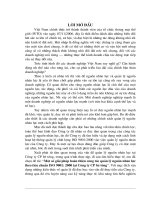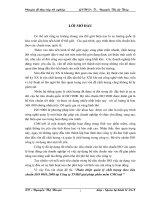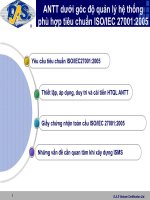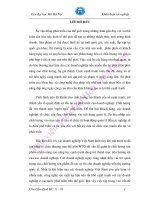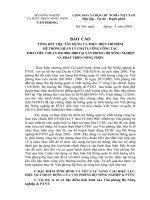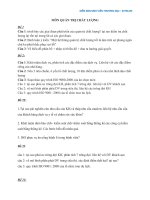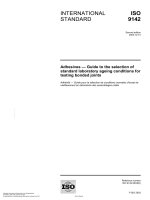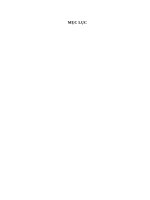tiêu chuẩn ISO 9142:2003
Bạn đang xem bản rút gọn của tài liệu. Xem và tải ngay bản đầy đủ của tài liệu tại đây (251.06 KB, 30 trang )
INTERNATIONAL
STANDARD
ISO
9142
Second edition
2003-12-15
Adhesives — Guide to the selection of
standard laboratory ageing conditions for
testing bonded joints
Adhésifs — Guide pour la sélection de conditions normales d'essai de
vieillissement en laboratoire des assemblages collés
--`,,`,-`-`,,`,,`,`,,`---
Reference number
ISO 9142:2003(E)
Copyright International Organization for Standardization
Provided by IHS under license with ISO
No reproduction or networking permitted without license from IHS
© ISO 2003
Not for Resale
ISO 9142:2003(E)
PDF disclaimer
This PDF file may contain embedded typefaces. In accordance with Adobe's licensing policy, this file may be printed or viewed but
shall not be edited unless the typefaces which are embedded are licensed to and installed on the computer performing the editing. In
downloading this file, parties accept therein the responsibility of not infringing Adobe's licensing policy. The ISO Central Secretariat
accepts no liability in this area.
Adobe is a trademark of Adobe Systems Incorporated.
Details of the software products used to create this PDF file can be found in the General Info relative to the file; the PDF-creation
parameters were optimized for printing. Every care has been taken to ensure that the file is suitable for use by ISO member bodies. In
the unlikely event that a problem relating to it is found, please inform the Central Secretariat at the address given below.
--`,,`,-`-`,,`,,`,`,,`---
© ISO 2003
All rights reserved. Unless otherwise specified, no part of this publication may be reproduced or utilized in any form or by any means,
electronic or mechanical, including photocopying and microfilm, without permission in writing from either ISO at the address below or
ISO's member body in the country of the requester.
ISO copyright office
Case postale 56 • CH-1211 Geneva 20
Tel. + 41 22 749 01 11
Fax + 41 22 749 09 47
Web www.iso.org
Published in Switzerland
ii
Copyright International Organization for Standardization
Provided by IHS under license with ISO
No reproduction or networking permitted without license from IHS
© ISO 2003 — All rights reserved
Not for Resale
ISO 9142:2003(E)
Contents
Page
Foreword ............................................................................................................................................................ iv
Scope...................................................................................................................................................... 1
2
Normative references ........................................................................................................................... 1
3
Materials................................................................................................................................................. 2
4
Apparatus............................................................................................................................................... 2
5
Specimens ............................................................................................................................................. 2
6
Procedure............................................................................................................................................... 2
7
Expression of results............................................................................................................................ 3
8
Test report.............................................................................................................................................. 4
--`,,`,-`-`,,`,,`,`,,`---
1
Annex A (normative) General conditions of ageing........................................................................................ 5
Annex B (normative) Atmospheric conditions for single-variable ageing ................................................... 6
Annex C (normative) Atmospheric conditions for multi-variable ageing ..................................................... 7
Annex D (normative) Atmospheric conditions for cyclic ageing .................................................................. 8
Annex E (normative) Special procedures ...................................................................................................... 23
Annex F (normative) Exposure to chemical attack ....................................................................................... 24
iii
© ISO 2003 — All rights reserved
Copyright International Organization for Standardization
Provided by IHS under license with ISO
No reproduction or networking permitted without license from IHS
Not for Resale
ISO 9142:2003(E)
Foreword
ISO (the International Organization for Standardization) is a worldwide federation of national standards bodies
(ISO member bodies). The work of preparing International Standards is normally carried out through ISO
technical committees. Each member body interested in a subject for which a technical committee has been
established has the right to be represented on that committee. International organizations, governmental and
non-governmental, in liaison with ISO, also take part in the work. ISO collaborates closely with the
International Electrotechnical Commission (IEC) on all matters of electrotechnical standardization.
International Standards are drafted in accordance with the rules given in the ISO/IEC Directives, Part 2.
The main task of technical committees is to prepare International Standards. Draft International Standards
adopted by the technical committees are circulated to the member bodies for voting. Publication as an
International Standard requires approval by at least 75 % of the member bodies casting a vote.
Attention is drawn to the possibility that some of the elements of this document may be the subject of patent
rights. ISO shall not be held responsible for identifying any or all such patent rights.
ISO 9142 was prepared by Technical Committee ISO/TC 61, Plastics, Subcommittee SC 11, Products.
--`,,`,-`-`,,`,,`,`,,`---
This second edition cancels and replaces the first edition (ISO 9142:1990), of which it constitutes a minor
revision.
iv
Copyright International Organization for Standardization
Provided by IHS under license with ISO
No reproduction or networking permitted without license from IHS
© ISO 2003 — All rights reserved
Not for Resale
INTERNATIONAL STANDARD
ISO 9142:2003(E)
Adhesives — Guide to the selection of standard laboratory
ageing conditions for testing bonded joints
1
Scope
This International Standard describes laboratory ageing conditions under which adhesive joints may be
exposed to various environmental influences — climatic or chemical — for the purpose of assessing the
effects of such influences on certain properties.
The ageing conditions are applicable to bonded assemblies and may be used to constitute a set of tests for
the evaluation of an adhesive.
The results obtained using the procedures described in this International Standard are not necessarily
applicable to the determination of the service life of a bonded assembly because there is no direct relation
between the test results and the behaviour of a bonded assembly over a period of time under service
conditions. However, for certain specific applications, experience with the procedures may enable a
correlation to be established.
NOTE
2
The ageing conditions should preferably be related to the specific application of the adhesive.
Normative references
The following referenced documents are indispensable for the application of this document. For dated
references, only the edition cited applies. For undated references, the latest edition of the referenced
document (including any amendments) applies.
ISO 175:1999, Plastics — Methods of test for the determination of the effects of immersion in liquid chemicals
ISO 291:1997, Plastics — Standard atmospheres for conditioning and testing
ISO 483:1988, Plastics — Small enclosures for conditioning and testing using aqueous solutions to maintain
relative humidity at constant value
ISO 3205:1976, Preferred test temperatures
ISO 4587:2003, Adhesives — Determination of tensile lap-shear strength of rigid-to-rigid bonded assemblies
ISO 4588:1995, Adhesives — Guidelines for the surface preparation of metals
ISO 4892 (all parts), Plastics — Methods of exposure to laboratory light sources
ISO 6238:2001, Adhesives — Wood-to-wood adhesive bonds — Determination of shear strength by compression
loading
ISO 9227:1990, Corrosion tests in artificial atmospheres — Salt spray tests
--`,,`,-`-`,,`,,`,`,,`---
1
© ISO 2003 — All rights reserved
Copyright International Organization for Standardization
Provided by IHS under license with ISO
No reproduction or networking permitted without license from IHS
Not for Resale
ISO 9142:2003(E)
3
Materials
3.1
De-ionized or distilled water, having a conductivity less than 200 µS/m.
3.2
Materials for ageing tests under special environmental conditions (see appropriate annex).
4
Apparatus
4.1 Conditioning chamber, meeting the requirements of ISO 483, capable of being maintained at a
temperature of (23 ± 2) °C and a relative humidity of (50 ± 5) %.
4.2
Dry-heat chamber, ventilated and adjustable to a temperature between 20 °C and 200 °C.
4.3 Humid chamber, meeting the requirements of lSO 483, adjustable to a relative humidity between 25 %
and 100 %. The chamber shall be equipped with
a)
a device to enable the temperature to be measured to within 1 °C;
b)
a device to enable the relative humidity to be measured to within 3 % R.H.
4.4
Cold chamber, adjustable to temperatures of (− 20 ± 3) °C and (− 40 ± 3) °C.
4.5 Controlled-pressure chamber, capable of operating at a pressure of 0,6 MPa1) and at an underpressure
of 0,092 MPa.
5
5.1
Specimens
Number and type
The number of test specimens, and the type used, will depend on the properties to be measured and the
required ageing conditions. The test specimens shall be prepared in accordance with the requirements of the
appropriate ISO standard test method. Prepare a sufficient number of specimens to provide homogeneous
sets of samples for testing and to provide control samples. The following International Standards, which do not
constitute an exhaustive list, are applicable: ISO 4587, ISO 4588, ISO 6238.
5.2
Conditioning
Specimens shall be conditioned in the conditioning chamber (4.1) for a minimum duration of 24 h before being
subjected to ageing. The conditioning shall be carried out after the adhesive has been cured in accordance
with the materials specification or the methods specified by the manufacturer of the adhesive.
6
6.1
Procedure
Tests before ageing
Determine the properties required for the sample under test by the appropriate test method, using specimens
conditioned in accordance with 5.2.
1)
2
1 MPa = 10 bar
--`,,`,-`-`,,`,,`,`,,`---
Copyright International Organization for Standardization
Provided by IHS under license with ISO
No reproduction or networking permitted without license from IHS
© ISO 2003 — All rights reserved
Not for Resale
ISO 9142:2003(E)
6.2
Ageing
Expose conditioned specimens to the environmental conditions as defined in Annex A to Annex F, as required.
6.3
Tests after ageing
Determine the properties after ageing in accordance with the procedure(s) of the appropriate standard(s).
Unless there are indications to the contrary in the Annexes, condition test specimens in the conditioning
chamber (4.1)
for (3 ± 1) h in the case of specimens exposed at a relative humidity higher than 50 %,
for at least 24 h for all other specimens,
before determining the properties.
In addition to the test results, all changes visible during the ageing and testing periods, including mode of
failure, shall be noted.
6.4
Controls
For control purposes, a representative group of specimens shall be kept in the conditioning chamber (4.1) for
the period of time covered by the ageing conditions selected.
7
Expression of results
For properties that can be measured, the results obtained are expressed as either
absolute values or
a relative variation with respect to the initial value.
For properties that cannot be measured, the nature of the effects observed shall be noted, e.g. rupture
between the substrate and adhesive, failure of cohesion of the adhesive joint due to partial or total corrosion
of the substrate beneath the adhesive, etc.
NOTE
It may be worth verifying that the variation in a measured property is caused only by the ageing process from
the following three values:
A
the value of the property measured before accelerated ageing;
B
the value of the same property measured on the control specimen which has undergone only intrinsic ageing at
(23 ± 2) °C and (50 ± 5) % R.H. (see 6.4);
C
the value of the property measured after ageing.
This can be done by calculating the following ratios:
a)
[(A – B)/A] × 100 (this ratio represents the intrinsic ageing during the period concerned);
b)
[(A – C)/A] × 100 (this ratio represents the overall ageing due to intrinsic ageing and the accelerated ageing under the
conditions specified in this International Standard);
c)
[(B – C)/A] × 100 (this ratio represents the degree of ageing due to ageing under the conditions specified in this
International Standard).
--`,,`,-`-`,,`,,`,`,,`---
3
© ISO 2003 — All rights reserved
Copyright International Organization for Standardization
Provided by IHS under license with ISO
No reproduction or networking permitted without license from IHS
Not for Resale
ISO 9142:2003(E)
8
Test report
The test report shall include the following information:
a)
a reference to this International Standard;
b)
a description of the type of ageing carried out, with reference to the relevant Annex(es) and the duration
of exposure and number of test cycles;
c)
the results of observations made in accordance with 6.3 (last paragraph) and Clause 7;
d)
details of any operations not laid down in this International Standard, as well as any incidents liable to
have had an effect on the results.
--`,,`,-`-`,,`,,`,`,,`---
4
Copyright International Organization for Standardization
Provided by IHS under license with ISO
No reproduction or networking permitted without license from IHS
© ISO 2003 — All rights reserved
Not for Resale
ISO 9142:2003(E)
Annex A
(normative)
General conditions of ageing
A.1 General
Whatever the type of ageing carried out, the temperature and duration of exposure, as well as the relative
humidity, shall, as far as possible, be selected from the preferred values given below. Other values may be
used if this is absolutely essential for technical reasons, but they shall be selected initially from the values
given in ISO 291 or ISO 3205 (the latter gives temperatures only).
A.2 Preferred temperature
Preferred temperatures are given, together with tolerances, in Table A.1.
A.3 Preferred exposure periods
Hours:
1 — 2 — 3 — 4 — 6 — 16 — 24 — 48 — 72 — 96
Weeks: 1 — 2 — 3 — 4 — 6 — 8 — 12 — 16 — 26 — 52
The number of cycles shall be selected to approach, as closely as possible, these preferred exposure periods.
A.4 Preferred relative humidities
15 %; (25 ± 5) %; (50 ± 5) %; (65 ± 5) %; 90 % to 100 %.
Table A.1 — List of preferred temperatures and tolerances
Temperature
Tolerances (to be used only in the absence of special
indications calling, in particular, for stricter tolerances)
– 40
±3
– 20
±3
+ 20
±2
+ 23
±2
+ 30
±2
+ 40
±2
+ 50
±2
+ 55
±2
+ 60
±2
+ 70
±2
+ 90
±2
+ 100
±2
+ 105
±3
+ 125
±3
+ 175
±3
5
© ISO 2003 — All rights reserved
Copyright International Organization for Standardization
Provided by IHS under license with ISO
No reproduction or networking permitted without license from IHS
--`,,`,-`-`,,`,,`,`,,`---
Values in degrees Celsius
Not for Resale
ISO 9142:2003(E)
Annex B
(normative)
Atmospheric conditions for single-variable ageing
B.1 General
In this type of ageing, the effect on the test specimen of only one environmental variable (e.g. temperature) is
considered, the other variables being fixed.
B.2 Set of conditions B1
The specimen is exposed to dry heat in the dry heat chamber (4.2), the temperature and period of exposure
being selected from the lists of preferred values in Annex A.
B.3 Set of conditions B2
The specimen is exposed to cold in the cold chamber (4.4), the temperature and period of exposure being
selected from the lists of preferred values in Annex A.
--`,,`,-`-`,,`,,`,`,,`---
6
Copyright International Organization for Standardization
Provided by IHS under license with ISO
No reproduction or networking permitted without license from IHS
© ISO 2003 — All rights reserved
Not for Resale
ISO 9142:2003(E)
Annex C
(normative)
Atmospheric conditions for multi-variable ageing
C.1 General
In this type of ageing, the simultaneous effect of two or more environmental variables on the specimen is
considered. In some cases, transfers from one chamber to another are necessary; unless otherwise specified,
such transfers shall be carried out in less than 3 min.
C.2 Set of conditions C1
The specimen is exposed in the humid chamber (4.3) to the simultaneous action of heat and humidity. The
temperature, exposure period and humidity are selected from the lists of preferred values in Annex A.
--`,,`,-`-`,,`,,`,`,,`---
NOTE
A further-accelerated ageing test using humid heat may be carried out at (70 ± 2) °C and 90 % to 100 %
humidity for 1 000 h.
7
© ISO 2003 — All rights reserved
Copyright International Organization for Standardization
Provided by IHS under license with ISO
No reproduction or networking permitted without license from IHS
Not for Resale
ISO 9142:2003(E)
Annex D
(normative)
Atmospheric conditions for cyclic ageing
D.1 General
In this type of ageing, the specimen is exposed for several successive periods, under single-variable and/or
multi-variable conditions, on a cyclic basis. In some cases, transfers from one chamber to another are
necessary; unless otherwise specified, such transfers shall be carried out in less than 3 min.
--`,,`,-`-`,,`,,`,`,,`---
The following cycles may be used:
Cycle D1 — Heat and humidity cycle
Cycle D2 — Heat, cold (thermal shock) and humidity cycle
Cycle D3 — Heat, cold and humidity cycle
Cycle D4 — Humid-heat and cold cycle
Cycle D5 — Dry-heat, humid-heat and cold cycle
Cycle D6 — Immersion in water and drying
Cycle D7 — Alternating immersion in water and drying
Cycle D8 — Immersion in boiling water and drying
Cycle D9 — Immersion in boiling water followed by drying, and then dry heat and re-immersion in boiling
water
Cycle D10 — Immersion in boiling water followed by drying, and then re-immersion in boiling water
Cycle D11 — Immersion in water, exposure to cold and exposure to dry heat
Cycle D12 — Immersion in salt solution and drying
D.2 Cycle D1 — Heat and humidity cycle
Humidity and period of exposure are fixed, while the temperature is varied. Two temperatures θ A and θ B are
selected from Table A.1 in Annex A.
The cycle requires two humid chambers (4.3) as follows:
chamber A, kept at a temperature θ A °C and a relative humidity of no lower than 90 %;
chamber B, kept at a temperature θ B °C and a relative humidity of not more than 30 %.
The cycle consists of the following exposure periods:
a)
(24 ± 1) h in chamber A;
b)
(24 ± 1) h in chamber B;
8
Copyright International Organization for Standardization
Provided by IHS under license with ISO
No reproduction or networking permitted without license from IHS
© ISO 2003 — All rights reserved
Not for Resale
ISO 9142:2003(E)
c)
(72 ± 1) h in chamber A;
d)
(48 ± 1) h in chamber B.
For the number of cycles, see Annex A, Clause A.3.
For conditioning after ageing, see 6.3.
A typical cycle, in which θ A is taken as (23 ± 2) °C and θ B as (55 ± 2) °C, is shown in Figure D.1.
--`,,`,-`-`,,`,,`,`,,`---
Key
X
exposure period (days)
Y
temperature (°C)
a
Not less than 90 % R.H.
b
Not more than 30 % R.H.
c
Cycle repeated n times
Figure D.1 — Typical conditions for cycle D1, in which θ A and θ B are taken as
(23 ± 2) °C and (55 ± 2) °C, respectively
D.3 Cycle D2 — Heat, cold (thermal shock) and humidity cycle
This cycle requires three chambers, as follows:
a humid chamber A (4.3), kept at a temperature θ A of either (40 ± 2) °C or (70 ± 2) °C and at a relative
humidity not lower than 90 %;
a cold chamber B (4.4), kept at a temperature θ B of either (– 20 ± 3) °C or (– 40 ± 3) °C;
a humid chamber C (4.3), kept at a temperature θ C of either (70 ± 2) °C or (100 ± 2) °C and at a relative
humidity of (50 ± 5) %.
9
© ISO 2003 — All rights reserved
Copyright International Organization for Standardization
Provided by IHS under license with ISO
No reproduction or networking permitted without license from IHS
Not for Resale
ISO 9142:2003(E)
The cycle consists of the following exposure periods:
a)
(16 ± 1) h in chamber A;
b)
(3 ± 1) h in chamber B;
c)
(5 ± 1) h in chamber C.
For the number of cycles, see Annex A, Clause A.3.
For conditioning after ageing, see 6.3.
--`,,`,-`-`,,`,,`,`,,`---
A typical cycle, in which temperature θ A is taken as 40 °C, θ B as − 20 °C and θ C as 70 °C, is shown in
Figure D.2.
Key
X
exposure period (h)
Y
temperature (°C)
a
Not less than 90 % R.H.
b
(50 ± 5) % R.H.
Cycle repeated n times
c
Figure D.2 — Typical conditions for cycle D2, in which θ A, θ B and θ C are taken as
40 °C, − 20 °C and 70 °C, respectively
10
Copyright International Organization for Standardization
Provided by IHS under license with ISO
No reproduction or networking permitted without license from IHS
© ISO 2003 — All rights reserved
Not for Resale
ISO 9142:2003(E)
D.4 Cycle D3 — Heat, cold and humidity cycle
This cycle requires a programmable humid chamber (4.3) capable of maintaining the required conditions of
temperature and humidity and able to change the conditions in the time specified in each case.
The cycle consists of the following operations:
expose for (15 ± 1) h at a temperature of either (40 ± 2) °C or (70 ± 2) °C and at a relative humidity not
lower than 90 %;
b)
change, in (60 ± 20) min, the temperature to (− 20 ± 3) °C or (− 40 ± 3) °C and expose for (2 ± 1) h;
c)
change, in (60 ± 20) min, the temperature to (70 ± 2) °C or (100 ± 2) °C and the relative humidity to
(50 ± 5) % and expose for (4 ± 1) h;
d)
change, in (60 ± 20) min, the temperature to (40 ± 2) °C or (70 ± 2) °C and the relative humidity to not
lower than 90 %.
--`,,`,-`-`,,`,,`,`,,`---
a)
At the end of the final cycle, change from the conditions in d) to the conditioning atmosphere (see 4.1) in
(60 ± 20) min.
For the number of cycles, see Annex A, Clause A.3.
For conditioning after ageing, see 6.3.
A typical cycle, in which the temperature of the first stage is taken as 40 °C, that of the second stage as
− 20 °C and that of the third stage as 70 °C, is shown in Figure D.3.
D.5 Cycle D4 — Humid-heat and cold cycle
This cycle requires a programmable humid chamber (4.3) capable of maintaining the required conditions of
temperature and humidity and able to change the conditions in the time specified in each case.
The cycle consists of the following operations:
a)
increase the temperature from ambient to (70 ± 2) °C in 30 min (this operation is carried out at the
beginning of the first cycle only);
b)
expose for 5 h ± 20 min at (70 ± 2) °C and at a relative humidity not lower than 90 %;
c)
change the temperature, in (60 ± 20) min, to (− 40 ± 3) °C and expose for 5 h ± 20 min;
d)
change the temperature, in (60 ± 20) min, to (70 ± 2) °C.
For the number of cycles, see Annex A, Clause A.3.
For conditioning after ageing, see 6.3.
The cycle is shown in Figure D.4.
11
© ISO 2003 — All rights reserved
Copyright International Organization for Standardization
Provided by IHS under license with ISO
No reproduction or networking permitted without license from IHS
Not for Resale
ISO 9142:2003(E)
X
exposure period (h)
Y
temperature (°C)
a
Not less than 90 % R.H.
b
(50 ± 5) % R.H.
Cycle repeated n times
c
Figure D.3 — Typical conditions for cycle D3, in which the temperatures of the first, second
and third stages are 40 °C, − 20 °C and 70 °C, respectively
12
Copyright International Organization for Standardization
Provided by IHS under license with ISO
No reproduction or networking permitted without license from IHS
© ISO 2003 — All rights reserved
Not for Resale
--`,,`,-`-`,,`,,`,`,,`---
Key
ISO 9142:2003(E)
Key
X
Y
exposure period (h)
temperature (°C)
a
Not less than 90 % R.H.
Cycle repeated n times
b
Figure D.4 — Humid-heat and cold cycle (cycle D4)
D.6 Cycle D5 — Dry-heat, humid-heat and cold cycle
This cycle requires three chambers, as follows:
a dry-heat chamber A (4.2), kept at a temperature of (55 ± 2) °C and at a relative humidity lower than
15 %;
a humid chamber B (4.3), kept at a temperature of (40 ± 2) °C and at a relative humidity not lower than
90 %;
a cold chamber C (4.4), kept at a temperature of (− 20 ± 3) °C.
--`,,`,-`-`,,`,,`,`,,`---
13
© ISOfor2003
— All rights reserved
Copyright International Organization
Standardization
Provided by IHS under license with ISO
No reproduction or networking permitted without license from IHS
Not for Resale
ISO 9142:2003(E)
The cycle consists of the following exposure periods:
a)
(48 ± 1) h in chamber A;
b)
(48 ± 1) h in chamber B;
c)
(24 ± 1) h in chamber C.
d)
(48 ± 1) h in chamber B.
For the number of cycles, see Annex A, Clause A.3.
For conditioning after ageing, see 6.3.
The cycle is shown in Figure D.5.
X
Y
exposure period (days)
temperature (°C)
a
b
Less than 15 % R.H.
More than 90 % R.H.
c
Cycle repeated n times
Figure D.5 — Dry-heat, humid-heat and cold cycle (cycle D5)
14
Copyright International Organization for Standardization
Provided by IHS under license with ISO
No reproduction or networking permitted without license from IHS
© ISO 2003 — All rights reserved
Not for Resale
--`,,`,-`-`,,`,,`,`,,`---
Key
ISO 9142:2003(E)
D.7 Cycle D6 — Immersion in water and drying
NOTE
This cycle is recommended for ageing porous materials (e.g. wood).
This cycle requires two chambers, as follows:
a controlled-pressure chamber A (4.5), kept at a temperature of (23 ± 2) °C and a pressure that can be
increased to an overpressure of 0,6 MPa and lowered to an underpressure of 0,092 MPa;
a humid chamber B (4.3), kept at a temperature of (23 ± 2) °C and at a relative humidity of (30 ± 5) %.
The cycle consists of the following operations:
a)
expose the test specimens, immersed in water, for 15 min in chamber A at an underpressure of
0,092 MPa;
b)
change the pressure to an overpressure of 0,6 MPa and expose for 2 h;
c)
change the pressure to − 0,092 MPa and expose for 15 min;
d)
change the pressure to an overpressure of 0,6 MPa and expose for 2 h;
e)
transfer to chamber B and expose for 10 days.
For conditioning after ageing, see 6.3.
For materials whose moisture content changes slowly (e.g. wood), mechanical tests shall be carried out, if
required, either by taking account of the moisture content of the material at the time of test or extending the
conditioning time to obtain a given moisture content.
Key
X1 exposure period (h)
X2 exposure period (days)
Y over/under pressure (MPa)
a
Exposure period in chamber A: 4 h + 30 min.
b
Exposure period in chamber B: 10 days at (30 ± 5) % R.H.
--`,,`,-`-`,,`,,`,`,,`---
The cycle is shown in Figure D.6.
Figure D.6 — Cycle D6 for immersion in water and drying
15
© ISO 2003 — All rights reserved
Copyright International Organization for Standardization
Provided by IHS under license with ISO
No reproduction or networking permitted without license from IHS
Not for Resale
ISO 9142:2003(E)
D.8 Cycle D7 — Alternating immersion in water and drying
NOTE
This cycle is recommended for ageing porous materials (laminates, etc.).
This cycle requires two chambers, as follows:
a dry-heat chamber A (4.2), kept at a temperature of (23 ± 2) °C;
a humid chamber B (4.3), kept at a temperature of (55 ± 2) °C and at a relative humidity of less than or
equal to 25 %.
The cycle consists of the following operations:
expose the test specimens immersed in water for 64 h in chamber A;
b)
expose for (8 ± 1) h in chamber B;
c)
expose, re-immersed in water for (16 ± 1) h in chamber A;
d)
expose for (8 ± 1) h in chamber B;
e)
expose, re-immersed in water for (16 ± 1) h in chamber A;
f)
expose for (8 ± 1) h in chamber B;
g)
expose, re-immersed in water for (16 ± 1) h in chamber A.
--`,,`,-`-`,,`,,`,`,,`---
a)
Conditioning after ageing: none; test the specimens immediately on completion of stage g), i.e. in the wet
condition.
The cycle is shown in Figure D.7.
Key
X
exposure period (h)
Y
a
temperature (°C)
Drying
b
Immersion in water
Figure D.7 — Cycle D7 for alternating immersion in water and drying
16
Copyright International Organization for Standardization
Provided by IHS under license with ISO
No reproduction or networking permitted without license from IHS
© ISO 2003 — All rights reserved
Not for Resale
ISO 9142:2003(E)
D.9 Cycle D8 — Immersion in boiling water and drying
NOTE
This cycle is recommended for ageing porous materials, in particular laminates bonded with phenolic adhesives.
This cycle requires three test chambers, as follows:
--`,,`,-`-`,,`,,`,`,,`---
a dry-heat chamber A (4.2), kept at a temperature of (100 ± 2) °C (since water boils at 100 °C only at an
atmospheric pressure of 0,1 MPa, the temperature of the boiling water is a variable and shall be
reported);
a humid chamber B (4.3), kept at a temperature of (55 ± 2) °C [when testing laminates, a temperature of
(50 ± 2) °C shall be used in order to ensure commonality with existing procedures] and at a relative
humidity of (30 ± 5) %;
a dry-heat chamber C (4.2), kept at a temperature of (23 ± 2) °C.
The cycle consists of the following operations:
a)
expose the test specimens, immersed in boiling water, for (4 ± 0,1) h in chamber A;
b)
expose for (20 ± 1) h in chamber B;
c)
expose, re-immersed in water, for (4 ± 0,1) h in chamber A;
d)
expose for (1 ± 0,1) h in chamber C.
Conditioning after ageing: none; test the specimens immediately on completion of stage d), i.e. in the wet
condition.
The cycle is shown in Figure D.8.
D.10 Cycle D9 — Immersion in boiling water followed by drying, and then dry heat
and re-immersion in boiling water
NOTE
This cycle is recommended for testing wood laminates.
This cycle requires three dry-heat chambers (4.2), as follows:
chamber A, kept at a temperature of (100 ± 2) °C (since water boils at 100 °C only at an atmospheric
pressure of 0,1 MPa, the temperature of the boiling water is a variable and shall be reported);
chamber B, kept at a temperature of (23 ± 2) °C and provided with a controlled air-flow of
(1,75 ± 0,3) m/s;
chamber C, kept at a temperature of (105 ± 3) °C and provided with a controlled air-flow of
(1,75 ± 0,3) m/s.
The cycle consists of the following operations:
a)
expose the test specimens, immersed in water, for 10 min in chamber A;
b)
expose for 4 min in chamber B;
c)
expose for 57 min in chamber C.
For the number of cycles, see Annex A, Clause A.3.
Conditioning after ageing: at the end of the final cycle, transfer to water at (23 ± 2) °C and maintain for at least
3 days. Testing shall be carried out on wet specimens.
The cycle is shown in Figure D.9.
17
© ISO 2003 — All rights reserved
Copyright International Organization for Standardization
Provided by IHS under license with ISO
No reproduction or networking permitted without license from IHS
Not for Resale
ISO 9142:2003(E)
X
Y
exposure period (h)
temperature (°C)
a
Immersion in water
Drying
b
Figure D.8 — Cycle D8 for immersion in boiling water and drying
18
Copyright International Organization for Standardization
Provided by IHS under license with ISO
No reproduction or networking permitted without license from IHS
© ISO 2003 — All rights reserved
Not for Resale
--`,,`,-`-`,,`,,`,`,,`---
Key
ISO 9142:2003(E)
Key
X
Y
exposure period (min)
temperature (°C)
a
Immersion in water.
Drying.
b
c
d
Dry heat.
Cycle repeated n times.
Figure D.9 — A typical cycle for immersion in boiling water followed by drying,
and then dry heat and re-immersion in boiling water
D.11 Cycle D10 — Immersion in boiling water followed by drying, and then
re-immersion in boiling water
This cycle requires three dry-heat chambers (4.2), as follows:
chamber A, kept at a temperature of (100 ± 2) °C (since water boils at 100 °C only at an atmospheric
pressure of 0,1 MPa, the temperature of the boiling water is a variable and shall be reported);
chamber B, kept at a temperature of (50 ± 2) °C and provided with a controlled air-flow of
(1,75 ± 0,3) m/s;
chamber C, kept at a temperature of (23 ± 2) °C.
--`,,`,-`-`,,`,,`,`,,`---
© ISO 2003 — All rights reserved
Copyright International Organization for Standardization
Provided by IHS under license with ISO
No reproduction or networking permitted without license from IHS
Not for Resale
19
ISO 9142:2003(E)
The cycle consists of the following operations:
a)
expose the test specimens, immersed in water, for (4 ± 0,1) h in chamber A;
b)
expose for (20 ± 1) h in chamber B;
c)
expose, re-immersed in water, for (4 ± 0,1) h in chamber A;
d)
keep in chamber C, still immersed in water, until a temperature of 23 °C is reached.
Conditioning after ageing: none; test the specimens immediately on completion of stage d), i.e. in the wet
condition.
--`,,`,-`-`,,`,,`,`,,`---
The cycle is shown in Figure D.10.
Key
X
exposure period (h)
Y
temperature (°C)
a
Immersion in water.
b
Drying.
Cooling in water.
c
Figure D.10 — Cycle D10 for immersion in boiling water followed by drying,
and then re-immersion in boiling water
20
Copyright International Organization for Standardization
Provided by IHS under license with ISO
No reproduction or networking permitted without license from IHS
© ISO 2003 — All rights reserved
Not for Resale
ISO 9142:2003(E)
D.12 Cycle D11 — Immersion in water, exposure to cold and exposure to dry heat
NOTE
This cycle is recommended for testing wood particle board.
This cycle requires three chambers, as follows:
a dry-heat chamber A (4.2), kept at a temperature of (23 ± 2) °C;
a cold chamber B (4.4), kept at a temperature of (− 20 ± 3) °C;
a dry-heat chamber C (4.2), kept at a temperature of (70 ± 2) °C.
The cycle consists of the following operations:
a)
expose the test specimens, immersed in water, for (72 ± 1) h in chamber A;
b)
expose for (24 ± 1) h in chamber B;
c)
expose for (72 ± 1) h in chamber C.
Conditioning after ageing: none; test the specimens immediately on completion of the cycle.
The cycle is shown in Figure D.11.
D.13 Cycle D12 — Immersion in salt solution and drying
D.13.1 Materials and apparatus
D.13.1.1
Salt solution, 5 % by mass.
Dissolve (5 ± 1) parts by mass of sodium chloride in (95 ± 1) parts of water.
The sodium chloride shall not contain more than 0,1 % by mass of sodium iodide or more than 0,5 % by mass
of other impurities. The pH of the solution shall lie between 6,5 and 7,2.
Compressed air, oil-free, at a pressure of 0,5 MPa.
D.13.1.3
Corrosion-resistant vessel, of sufficient size to contain the test specimen(s) immersed in salt
solution (D.13.1.1), capable of being maintained at (23 ± 2) °C, and fitted with a corrosion-resistant aeration tube
leading down to the bottom of the vessel and across the bottom. The end of the tube shall be closed and the
horizontal part perforated to allow streams of compressed air (D.13.1.2) to be passed through the salt solution.
D.13.2 Procedure
The cycle consists of the following operations:
a)
immerse the test specimen(s) in the salt solution (D.13.1.1) for (8 ± 1) h at (23 ± 2) °C in the vessel
(D.13.1.3), passing compressed air (D.13.1.2) through the solution continuously;
b)
suspend in air at a temperature of (23 ± 2) °C for (16 ± 1) h.
Repeat the cycle five times.
On completion of the fifth cycle, immerse the test specimen(s) for (48 ± 1) h at (23 ± 2) °C in the salt solution
in the vessel.
All transfers from one medium to another shall be carried out in less than 3 min.
For conditioning after ageing, see 6.3.
21
© ISO 2003 — All rights reserved
Copyright International Organization for Standardization
Provided by IHS under license with ISO
No reproduction or networking permitted without license from IHS
Not for Resale
--`,,`,-`-`,,`,,`,`,,`---
D.13.1.2
